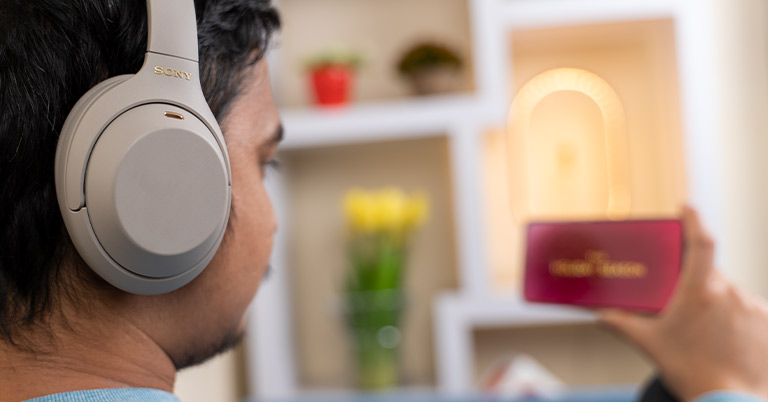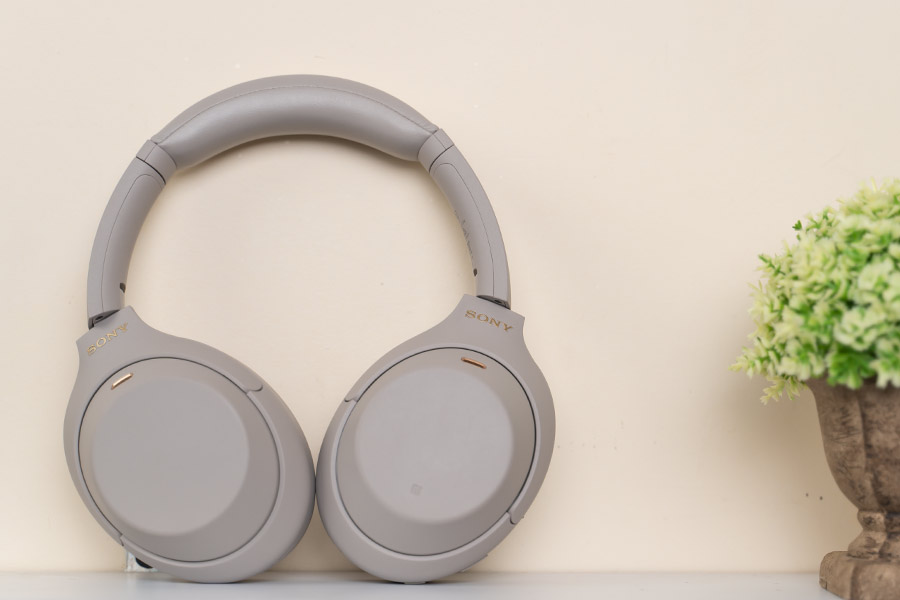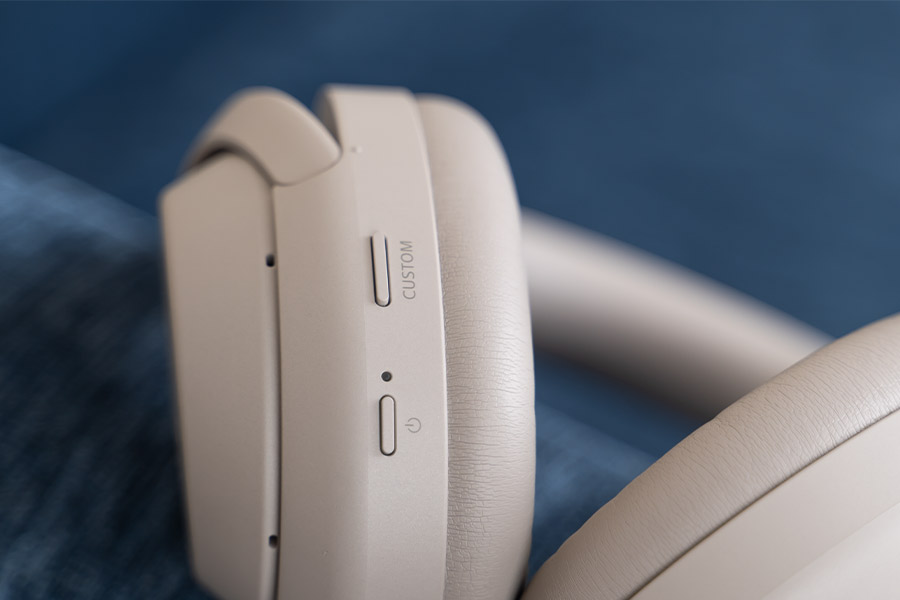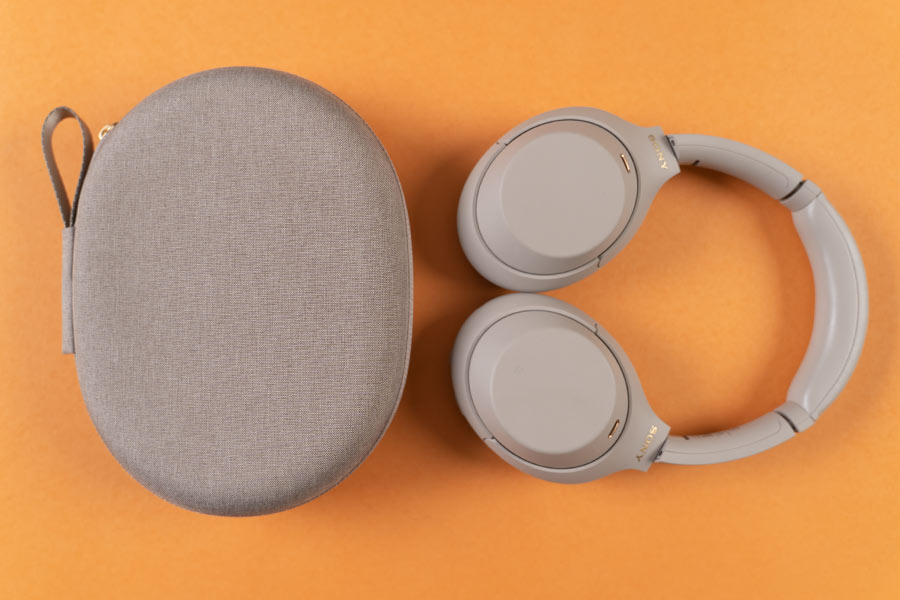
Over the past couple of years, Sony has managed to become almost synonymous with noise-canceling technology—a feat once held by other companies like Bose. 2018’s WH-1000XM3 from the company can be accredited as one of the major drivers of its achievement. From its cozy design to excellent sound quality and most importantly—the industry-leading noise cancellation, it still stands out as one of the best Bluetooth headphones you can buy. And now, it’s got a much-awaited successor. The new Sony WH-1000XM4 builds on its predecessor while bringing a couple of nuanced, yet necessary upgrades. Well then, how has Sony managed to outdo itself with the WH-1000XM4 noise-canceling headphone—allow me to discuss in this review.
Sony WH-1000XM4 Specifications:
- Weight: 255 grams (approx.)
- Headphone Type: Closed, Dynamic
- Driver Unit: 1.57″ (40mm), dome type (CCAW Voice coil)
- Sensitivity: 105 dB/mW (when connected via cable with the headphone turned on); 101 dB/mW (when connected via cable with the headphone turned off)
- Frequency Response: 4Hz – 40,000Hz
- Frequency Response (Bluetooth Communication): 20Hz – 20,000Hz (44.1 kHz), 20Hz – 40,000Hz (LDAC 96 kHz, 990kbps)
- Input: Stereo mini-jack
- Bluetooth: v5.0, 30 ft. (10 m) effective range
- Bluetooth Profile: A2DP, AVRCP, HFP, HSP
- Frequency Range: 2.4GHz band
- Audio Codecs: SBC, AAC, LDAC
- Active Noise Cancelling: Yes, QN1 processor
- Battery Life:
- 30 hrs (NC on), 38 hrs (NC off) – continuous music playback
- 30 hrs (NC on), 200 hrs (NC off) – waiting time
- Battery Charge Time: 3 hrs (approx.), 10 minutes quick charge (5-hour playback)
- Features: NFC, DSEE Extreme, Edge AI, 360 Reality Audio, Speak to Chat, Precise Voice Pickup, Touch Sensor control (right earcup)
- In The Box: Headphone, Carrying Case, Headphone Cable, USB-C Cable, Plug Adaptor for In-flight Use
- Color Options: Black, Silver
- Companion App: Sony Headphones Control (Android | iOS)
- Price in Nepal: Rs. 54,000 (with 1-year brand warranty)
Sony WH-1000XM4 Review:
Design & Comfort
- Premium plastic build with soft earcups
- Closed-back, over-the-ear design
Starting with the design, Sony hasn’t made any major revision in terms of how the X(Mark)4 looks and feels compared to the XM3. It has a premium plastic build with soft, comfortable earcups, while also being pervious to sweat, water damage. Yes, these are still not IP-certified against any level of ingress protection. So, you gotta be extra careful when taking these out on your workout sessions or maybe even on humid days.
Likewise, XM4’s earcups are incredibly plush and offer a tight fit. The headband could still use a little bit of work though. They’re a bit narrow and its padding is also considerably tighter to my liking. As a result, I often found myself adjusting the headphones on my head every now and then. Because of the aforementioned attributes of the headband, you can also feel this mild, yet consistent degree of pressure, stiffness resulting in a fatigued wearing experience in the long-run. Furthermore, after wearing it for a while, it does start to feel quite hot.
Adjusting the headband
I did try adjusting the length of the headband for a better fit. But, losing the firmness turned out to be an even worse tradeoff over the minimal discomfort. Since I don’t put on closed-back over-the-ear headphones like the XM4 that often, this may be the inexperienced side of me talking. Having used these pair of headphones for a little less than a month now, I would say I’ve been relatively more numb to the unease.

But before you get any wrong idea, let me reiterate: the degree of discomfort was always marginal, to begin with. And if you’re someone who’s used to these kinds of headphones, the Sony WH-1000XM4 should feel right at home.
Moving on, it is available in either black or silver color options—just like its predecessor. With its overall matte finish with gold-accented Sony logos on either side, these headphones gracefully matched my style too. Something that blends well with the ambiance and nothing remotely flashy—yeah, that’s the sweet spot. Anyway, the left earcup has the NFC engraving as well as all the physical buttons, the LED indicator, and the 3.5mm headphone jack. On the contrary, the right earcup houses the touch sensor control panel, and a USB-C charging port.
Pairing & Control
- Bluetooth v5.0, NFC connectivity
- Power, Custom button (customizable)
- Touch sensor control (right earcup)
- 3.5mm aux connection
Getting to pairing the XM4 with your phone, tablet, PC or other device is fairly boilerplate. Now equipped with Bluetooth 5.0, all you gotta do is press the dedicated power button for a couple of seconds to turn it on; and then follow the due diligence to get it working with your device. Like I said earlier, it also retains NFC connectivity. So, if your phone supports NFC, connecting with the XM4 is all the more seamless. Just tap the NFC icon on the headphone, and you’re good to go.
Additionally, there’s also 3.5mm aux port for wired connection. This has been, and for the foreseeable future, looks to rule reign supreme over its wireless counterpart. True audiophiles with trained ears always favor wired audio accessories for reasons more than one. From their high-bandwidth, low-latency audio streaming to other advantages, most of the time, I went down the wired route as well. As I discovered in the span of the review, the Sony WH-1000XM4 doesn’t sound all that different whether you’re connecting your device via Bluetooth or the aux cable.
And that goes beyond trying to awaken the dormant audiophile in me, no. I was surprised to see that on the box of the XM4, it has the “Made for iPhone | iPod” branding—just like on XM3. Yeah, iPod isn’t something that comes up that often in today’s conversations and is almost a retro piece of tech that I cherish with all my heart. Therefore, I connected my iPod Classic with the headphone to test out its audio quality. I don’t really know what or how Sony optimized it for the iPod, but it sounded great—so I guess that’s all that matters in the end.
Hello, multipoint connection!
More importantly, the XM4 brings one of the most demanded features which was lacking in its predecessor—multipoint connection. You can now simultaneously pair these headphones to two devices at once and seamlessly switch between them. I must admit, I found it more useful than I’d presumed. During work, I tend to stream my tunes from my laptop and therefore connected the XM4 to it, while also pairing it with my phone.

With this, any time I received a call, I could just toggle the media playback from the “Sony | Headphones Connect” app. Or, you can also turn off the Bluetooth settings of the desired device to disable its playback. Except for the prompt notification which reads “Bluetooth device 1/2 dis/connected”, I didn’t notice any delay when switching between two devices either. So, kudos to Sony for listening to its customer feedback and introducing such a practical feature. However, the multi-device connection does come at the sacrifice of LDAC codec, as both devices default to AAC streaming under this setting.
Besides the power button, there’s also a “Custom” button which was labeled “NC/AMBIENT” on the XM3. Frankly speaking, calling it feels like a bit of a reach; as all you can do is set it to either trigger ambient sound control, Google Assistant, or Amazon Alexa. Expectedly, I set it to the foremost option since that’s actually the most practical of the three (at least for me)—and also because I can already trigger Google Assistant by long-pressing the right earcup.
The touch sensor is slightly conflicting
Anyway, the touch control works well once you get the hang of it. Swiping it left/right plays the next/previous track while an up/down swipe controls the volume level. Similarly, you can double-tap to play/pause the audio, whereas the same action can also accept or hang-up on calls. But I would say that the control feels slightly off sometimes. The headphone would, on rare occasions, misread my swipe-up gesture to turn up the volume and activate Google Assistant instead. Unfortunately, the touch sensor is non-functional when connecting it via the 3.5mm jack.
Noise Cancellation
- Sony QN1 HD noise-canceling processor
- Adaptive Sound Control, Speak-to-Chat, Quick Attention
Now, let’s talk about the noise-cancellation properties of the XM4. Equipped with the same QN1 HD noise-canceling processor as its predecessor, it’s no wonder why people love this thing! The Dual Noise Sensor technology makes use of two microphones on each earcup; that feed the captured ambient to the processor. Then, the improved algorithm alongside the new Bluetooth Audio SoC dynamically adjusts music to deter noise signals for a soothing listening experience.
For the best noise-canceling experience, Sony recommends you optimize it to the way you put on the headphone (the position of your hair, whether you wear glasses or not) and a couple of other factors like atmospheric pressure. Sounds intricate but that couldn’t be farther from the truth. All you gotta do is long-press the custom button for a couple of seconds or use the app to begin the optimization process—and the whole operation is completed within 10 seconds.
In any case, as expected, the XM4’s noise cancellation is top-notch. It obviously can’t block every noise signal and works the best against low (fan noise, HVAC, etc.) and even mid-frequency ambient sounds. But once you turn on some music at a respectable volume, the headphone then sucks you into your own blissful realm, void of any disturbances from outside. Under regular setting like a living room with a TV running in the background, people talking, etc. the XM4 manages to stay excellently quiet while I could faintly hear the TV program or the ongoing conversation. Yet, once again, play some tunes and it’s all gone—almost.
Real-life scenario
I also took a stroll outside with the XM4 where construction work was going on to pitch the road. Here, the sound coming from the pitching machine dominated my listening experience with bike horns distinctively making their way into the headphone as well—while other ambient white noises like people talking were practically imperceptible. Furthermore, during my test, I also tried out its noise-canceling prowess against different noisy scenarios like an active office, campfire, and airplane cabin—from a pre-recorded audio file.

For this, I confined myself into a small, quiet room (approx. 200 sq. feet) and played the said audio from the Galaxy Z Fold 2’s incredible stereo speakers. Now, I realize this might not be the most technical/realistic of testing scenarios—but, I firmly believe it gives a fair assessment of XM4’s noise-canceling ability. Anyway, under these settings, the XM4 managed to drown out most of the noise. The rumbles from the airplane cabin or the office’s HVAC system do manage to slip in and so does the crackling of the woodfire. But, the difference in putting on the headphone with NC-on is immaculate.
Moving on, the Sony WH-1000XM4 is blessed with a bunch of ways noise-canceling works on this headphone. First off, there’s this thing called “Adaptive Sound Control” that dynamically lets in different levels of ambient sound depending on your frequent location. For instance, the noise cancellation is dialed down when you’re at a bus station or such where you’d want to hear the surrounding. On the other hand, it is cranked up to the max in settings like your room where you wouldn’t want any distraction. I particularly didn’t find this very useful as I don’t travel around much. But if you’re someone who can make use of it, this is a nice feature to have.
Speak-to-Chat
Another headlining feature on the XM4 is called “Speak-to-Chat” which works exactly how it sounds. It detects when you start speaking and turns off the music while letting in ambient sound. Yet, I honestly don’t see a respectfully practical use-case for this feature. Like, if I’m just listening to my music and start singing along—it’s activated. That’s not all. This feature can be accidentally triggered even when you are grunting or clearing your throat.
Changing the voice detection sensitivity to low did help with the accidental triggers, although I’m still weirded out when it cuts off my music. You can manually turn it off by clicking the Custom button or placing your hand over the right earcup. This mode also automatically reverts back in 30 seconds by default (with 15 seconds as the lowest value), which is some sort of relief—but still annoying. So, I turned it off altogether. Maybe Sony could come up with an intelligent way to detect whether the wearer is trying to engage in a conversation, or just jamming to the music.
Nevertheless, the “Quick Attention” feature comes in quite handy though. As I mentioned earlier, by placing your hand over the right earcup, the Sony WH-1000XM4 lets in the ambient noise, while turning down the music volume—a feature I personally didn’t find that useful throughout my review. The thing is, it feels kinda awkward talking to people this way—and a tad bit disrespectful too. Like, if I wanted to engage in a conversation, personally speaking, I would just take off the headphones altogether. Still, for a quick chat, this feature is very helpful indeed.
Audio Quality
- 40mm CCAW driver with LCP diaphragm
- 4 Hz – 40,000 kHz frequency response
- SBC, AAC, LDAC audio codecs
- Dual-microphones in each earcup
Even though the XM4 is a noise-canceling-first headphone, its audio quality is equally spectacular. It has the same 1.57” (40mm) circumaural driver with aluminum-coated LCP diaphragm, and 4Hz-40kHz of frequency response. Likewise, it also supports DSEE Extreme for upscaling compressed digital music files in real-time. I tried streaming music from Spotify, YouTube, and my local MP3, FLAC audio files and I gotta admit—I couldn’t really tell the difference between turning DSEE Extreme on or off.
The XM4 also supports Sony 360 Reality Audio technology; and the company even provides one year’s free subscription code inside the box. Unfortunately, I couldn’t experience this feature as it works only on a couple of streaming services like Deezer, Tidal, nugs.net—and I don’t have a subscription to any of those.

In any case, it is a decent pair of headphones for audiophiles. However, you might be slightly disappointed to hear that unlike XM3, it doesn’t support Qualcomm’s aptX and aptX HD audio. Anyhoo, the default audio profile of the XM4 was a-bit distasteful for me. So, using the Headphones Connect app, I went on to tweak the equalizer setting on the Sony WH-1000XM4 for the review. After messing around with it for a while, I was finally happy with the “Excited” preset, with “Clear Bass” dialed down to +6.
Excellent listening experience
To test the audio quality for the review, I listened to differnet kinds of songs on the Sony WH-1000XM4. Listening to the Blade Runner 2049 main theme by Hans Zimmer & Benjamin Wallfisch was a breathtaking experience. The booming rumbles across the track and the high frequencies sounds ethereal—almost making up for the fact that I missed this masterpiece on the theater. Florence + The Machines’ Cosmic Love has great vocal separation and I could almost clearly enjoy the drum, harp, and other instruments. But, there is some distortion in the high frequencies when cranking the volume to 80% or louder.
Moreover, Bob Dylan’s Man of Constant Sorrow has a clear, raspy voice (signature Dylan) and warm guitars. I also rewatched Akira (1988) and now have a newfound respect for the film’s sound design team. From the rowdy, chaotic ambiance of Neo Tokyo to the grueling and ghastly soundtrack, XM4 was able to deliver in almost every aspect of the movie. In addition, the microphone quality of the XM4 is pretty nice. The audio is clear and I had no problem with my calls or video meetings. Even in a fairly noisy environment, I received no complaint from the receiver’s end about the quality of my voice.
Oh, I almost forgot to mention. There’s also a sensor on the left earcup of the headphone which detects whether you’ve put the headphones on or not. Sad to say, it didn’t reach my expectation and was quite inconsistent. I found that the sensor worked best when I’d unnaturally extend the headband to take it off. Weird. If you just slide it off, it would still continue to play the audio most of the time.
Also, resuming the playback is at odds with what you’d normally expect. To sum up, the XM4 desperately needs a firmware upgrade to fix this issue. During my review period, I only received a single update on the Sony WH-1000XM4 that addressed its pairing issue with a Windows machine.
Battery Life
- Up to 30 hours listening time with Noise-Canceling
- USB-C charging connection (plus quick charge feature)
Getting to the battery, the WH-1000XM4’s endurance remains the same as its predecessor. This is pretty commendable considering how it weighs a gram lesser than the XM3 while coming with additional sensors. Sony says these headphones can last up to 30 hours with noise-canceling turned on, and 8 more hours with NC off. During my review, I got around 20-22 hours of playback on the Sony WH-1000XM4. I usually listened to music around 70% volume with AAC codec, DSEE Extreme on, and most of the time with noise-cancellation turned on as well.

As you’d expect, the mileage will vary depending on how you tune the headphones to your liking. The XM4 also supports a quick charge feature that can get you 5 hours of juice with just 10 minutes of charging. To note, I never got to deplete its charge to nill—and hooked up the charger with approximately 10% battery remaining. Here, it took me about 2 hours and 28 minutes to fully juice up the headphone via the USB-C cable. Also, the USB cable that comes within the box could’ve been a little longer.
Conclusion
Wrapping it all up, the WH-1000XM4 once again cements Sony’s dominance in the noise-cancellation industry. It improves on the already impressive set of headphones and brings some subtle, quality-of-life upgrades that many would appreciate—including me. It’s a solid pair of headphones that offer the best-in-class noise-free listening experience at a premium price. And hey, if you want the best-of-the-best and the XM4 falls under your budget, it’s an easy recommendation. Having said that, if you already own a pair of WH-1000XM3, there is little to zero reason to do so, unless you really want a taste of the iterative improvements.
Songs referenced in the Sony WH-1000XM4 review:
- Hans Zimmer, Benjamin Wallfisch — 2049
- Florence + The Machine — Cosmic Love
- Bob Dylan — Man of Constant Sorrow
Sony WH-1000XM4 Review: Pros & Cons
Pros:
- Excellent design, soft earcups
- Bluetooth, NFC connectivity
- Industry-leading noise-cancellation
- Dynamic NC (Adaptive Sound Control, etc.)
- Can connect to two devices at once
- Great audio reproduction, DSEE Extreme
- Admirable battery endurance
Cons:
- Could be slightly discomforting with a prolonged usage
- The touch sensor might occasionally misbehave
- LDAC codec compromised upon multipoint connection
- No aptX, aptX HD audio codecs like its predecessor
- No dust/water ingress protection of any kind







![Best Gaming Laptops in Nepal Under Rs. 250,000 (रु 2.5 Lakhs) [2025] Best Gaming Laptops Under 2.5 lakhs in Nepal [Feb 2025 Update]](https://cdn.gadgetbytenepal.com/wp-content/uploads/2025/02/Best-Gaming-Laptops-Under-2.5-lakhs-in-Nepal-Feb-2025-Update.jpg)
![Best Gaming Laptops in Nepal Under Rs. 120,000 (रु 1.2 Lakhs) [2025] Best Budget Gaming Laptops Under Rs 120000 in Nepal 2025 Update](https://cdn.gadgetbytenepal.com/wp-content/uploads/2025/05/Best-Budget-Gaming-Laptops-Under-Rs-120000-in-Nepal-2024-Update.jpg)
![Best Laptops Under Rs. 80,000 in Nepal [2025] Best Laptops Under 80,000 in Nepal March 2025 Update](https://cdn.gadgetbytenepal.com/wp-content/uploads/2025/03/Best-Laptops-Under-80000-in-Nepal-March-2025-Update.jpg)
![Best Gaming Laptops in Nepal Under Rs. 200,000 (रु 2 Lakhs) [2025] Best gaming lapotp under 2 lakhs Nepal Feb 2025](https://cdn.gadgetbytenepal.com/wp-content/uploads/2025/01/Best-Gaming-Laptops-Under-2-Lakh-Nepal-Feb-2025-Update.jpg)

![Best Mobile Phones Under Rs. 15,000 in Nepal [Updated 2025] Best Phones Under 15000 in Nepal 2024 Budget Smartphones Cheap Affordable](https://cdn.gadgetbytenepal.com/wp-content/uploads/2024/03/Best-Phones-Under-15000-in-Nepal-2024.jpg)
![Best Mobile Phones Under Rs. 20,000 in Nepal [Updated] Best Mobile Phones Under NPR 20000 in Nepal 2023 Updated Samsung Xiaomi Redmi POCO Realme Narzo Benco](https://cdn.gadgetbytenepal.com/wp-content/uploads/2024/01/Best-Phones-Under-20000-in-Nepal-2024.jpg)
![Best Mobile Phones Under Rs. 30,000 in Nepal [Updated 2025] Best Phones Under 30000 in Nepal](https://cdn.gadgetbytenepal.com/wp-content/uploads/2025/01/Best-Phones-Under-30000-in-Nepal.jpg)
![Best Mobile Phones Under Rs. 40,000 in Nepal [Updated 2025] Best Phones Under 40000 in Nepal 2024 Smartphones Mobile Midrange](https://cdn.gadgetbytenepal.com/wp-content/uploads/2024/02/Best-Phones-Under-40000-in-Nepal-2024.jpg)
![Best Mobile Phones Under Rs. 50,000 in Nepal [Updated 2025] Best Phones Under 50000 in Nepal](https://cdn.gadgetbytenepal.com/wp-content/uploads/2025/01/Best-Phones-Under-50000-in-Nepal.jpg)
![Best Flagship Smartphones To Buy In Nepal [Updated] Best flagship phone 2025](https://cdn.gadgetbytenepal.com/wp-content/uploads/2024/07/Best-Flagship-Phones-who-is-it-ft-1.jpg)